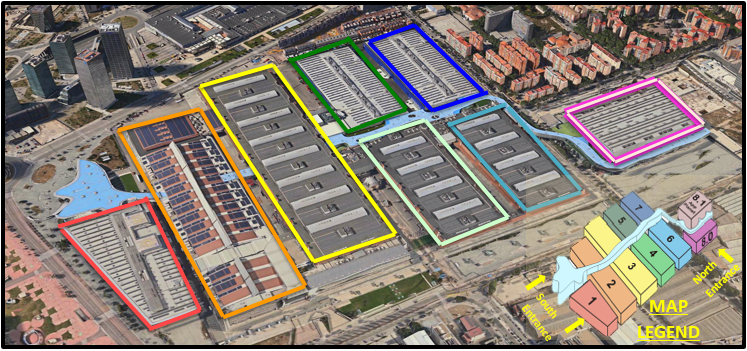Every year a new attendance record is set at Mobile World Congress by networkers participating from over 200 countries across the globe. This grand attendance of industry-defining vendors, technology enthusiasts and exhibitors triggers an explosive growth in the number of Wi-Fi capable devices being brought to the event. For MWC 2014, Cisco partnered with Fira Gran Via and GSMA to pull off one of the most successful high density Wi-Fi network deployments in the history of global tech events. This blog kicks off a series to provide a glimpse of behind the network, into the design stages, and the course of actions undertaken to implement a robust high density wireless network which served more than 22,000 concurrently connected unique devices and a total of 80,880 devices throughout the event. Full details in whitepaper here.
Setting the Scene
Divided into eight massive exhibition halls, Fira Gran Via covers around 3 million square feet (280,000 square meters) of area which also includes outdoor areas, restaurants, conference rooms, network lounges and a continuous elevated walkway flowing through the entire venue. Higher the environmental complexity, the more fun and challenging it is to achieve the right wireless design for a pervasive network that meets all the needs.

Generally, the physical design of large convention and exhibition halls bear an impish knack of unfavorable conditions for a ubiquitous high density Wi-Fi network, owing mostly to the lofty ceiling heights and construction components.The presence of numerous other Wi-Fi-enabled devices in the same arena during the show times just adds to this adversity. With precise planning, design implementations, and a seasoned high density wireless expertise, Cisco adequately conquered every major environmental challenge.
Here’s a look at the initial implementation stage. Initial site survey analysis took place months before the show to systematically understand the areas to cover. This first stage of analysis allows to determine the AP locations and distances between them. Once the final designs are ready, the access points are mounted using a crane lift as seen in the picture below.

Besides months of network planning, multiple site visits and implementing the appropriate designs, there is one critical ingredient that the entire project heavily depends on – the choice of the right infrastructure. No matter how much effort you put in your high density designs, only the right set of hardware can help achieve the desired outcome.
Below is a grid view of the Cisco wired and wireless gear selected to model the MWC high density network architecture.

Every wireless design architect appreciates the significance of high gain directional antennas in high density deployments. Cisco’s wide range of specially designed directional antennas allows the desired level of focus to direct the RF in smaller coverage areas leading to more effective cell isolation and co-channel interference management, especially for the 2.4 GHz network.
Mobile World Congress 2014 – Behind the Wi-Fi Network whitepaper covers all the tips and tricks for building a solid high density Wi-Fi network including RX-SOP, Beamforming, and Radio Resource Management. The next blog in this series will focus on the site surveys conducted to lead up to going live with our high density network at MWC.


CONNECT WITH US